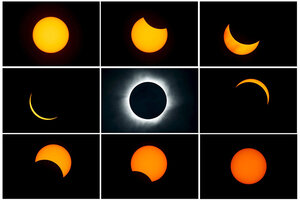What makes 2017's 'Great American Eclipse' so great?
A year from Sunday, those in the continental United States will be treated to a solar eclipse, whose path of totality stretches from Oregon to South Carolina.

A combination photograph shows the beginning (top left) to the end (bottom right) of a total solar eclipse as seen from the beach of Ternate island, Indonesia, March 9, 2016.
Beawiharta/Reuters
Exactly one year from Sunday, a rare solar event will unfold.
On August 21, 2017, a total solar eclipse will be visible to spectators across the continental United States. The event, which has been dubbed the Great American Eclipse, will parade along its narrow “path of totality” from Oregon to South Carolina, astronomers say.
On average, there are about two solar eclipses (and two lunar eclipses) every year. So what makes this one so special?
Eclipses are caused by close alignment of the Earth, sun and moon. When our planet passes between the two celestial bodies, its shadow blocks out the full moon and produces a lunar eclipse. A solar eclipse occurs when a new moon blocks out the sun from Earth’s vantage point.
If the Earth and moon orbited in the same plane, there would be two eclipses every month – a lunar eclipse during every full moon, and a solar eclipse for every new moon. But in reality, the moon orbits just 5 degrees off-kilter from our ecliptic orbit. The two intersect about twice per month at points called nodes. Eclipses occur only when the nodes line up with the new moon or full moon. As a result, there are only about four partial eclipses annually.
Total eclipses are even less frequent. They only occur once every 18 months, and the complete effect can only be seen along a 70-mile wide “path of totality,” which may not even pass through populated areas.
The last time such an eclipse was visible in the US, Rod Stewart was topping the charts with “Do Ya Think I’m Sexy?” and the Pontiac Trans Am ruled the road. On February 26, 1979, astronomers and hobbyists flocked to the Pacific Northwest by the busload to see darkened skies and a dramatic ring of exposed light around the moon. Solar storms made for an even more brilliant show, but the event was visible only in a handful of states.
When astronomers announced 2017’s event, a wave of “eclipse tourism” swept over small-town America. The upcoming total eclipse is slated to be a US-exclusive – the first since 1776. Only those within the path of totality, which spans from Oregon to South Carolina, will be able to witness the full effect.
"If you are in that path of totality, you are seeing the main event, but if you are off to the side – even where the sun is 99 percent covered by the moon – it is like going up to the ticket booth of a baseball or football stadium but not going inside," Jay Pasachoff, an astronomer at Williams College, told Space.com.
The next Great American Eclipse won’t come around until April 2024. Luckily, the 2017 eclipse will be partially visible throughout the entire continental US. Just make sure you put on protective eyewear, or build a shoebox eclipse viewer before trying to catch a glimpse.

